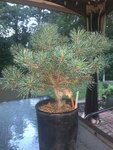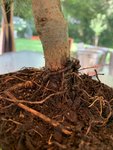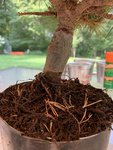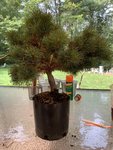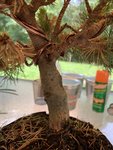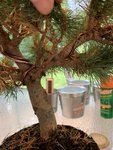Just trying to formulate a plan in my head. Still not sure when exactly to take those next steps. How do you get from here to selecting primary branches isn’t clear to me.
In business (or at least the business I was in) we made 5 year plans and modified them monthly. We also had annual plans that we modified weekly. There is a certain amount of similarity in creating bonsai.
A fundamental is to understand that JWP doesn't bud back on bare wood - new buds only appear at the terminal or from the bases of fascicles (needle groups). This means the foliage will, forever, just keep moving farther away from the trunk. So your early priority is to preserve foliage close to the trunk --> wire and maybe prune to assure light gets to this interior foliage. Exactly how you position the foliage and maybe eliminate some branches is going to be influenced by your notions of the bonsai image you are wanting to pursue --> your 5 year plan,
What kind of trunk do you want? I prefer curvy ones, but the bottom section of yours is too thick to bend, I think. You may be able to bend the stuff above, whorl branches or the section of trunk above that. This bottom section of the trunk also has a graft union that you will want to disguise. One way to do that would be to bend branches down so that they obscure the view of this part of the trunk, which means you'll be pursuing a 'mound of foliage' image. If this is your choice, you would want all those whorl branches and little else. Further, no one is ever going to see the nebari, so it doesn't matter.
Otherwise, trunk development is your game for the next few years. A nice thing about pines is that the branch tip with the highest elevation becomes dominant. The handy thing is that in addition to thickening most rapidly, it will suppress the vigor of the branches below = that foliage will not move away from the trunk quite so fast!! To do this, you must first decide if the lower trunk section is about as thick as you want, because it won't thicken much when you chop off the present trunk just above the whorl. So, you may want to do what everyone seems to be encouraging you to do = learn to keep it alive / let it grow. But, meanwhile, think ahead to the day that you do lop off the top. You will be selecting one of those whorl branches to be the next trunk section. You will need at least one 'opposite' whorl branch to be the lowest branch of the eventual bonsai. I say 'opposite' because the simple idea is that you'll have a branch on the outside of the kink or one that appears to be. The possible problem is that the straight forward choice may wind up with the foliage too far away from the trunk. If, instead, this branch came from behind, it could be bent around to put the foliage close to the trunk.

So, maybe you will keep two for a while to see how it works out, putting off the decision until having both is beginning to make a knuckle. As to the branch you choose to be the next trunk segment, you want a similar whorl on it, but at a shorter distance from the whorl below than that first whorl is from the ground. Maybe you want to bend this around a bit when wiring it up so that this internode appears shorter than it is. Then you let this sacrifice grow until the second trunk section is nearing the thickness of the base trunk --> voila! tapering trunk. Possibly you now rinse and repeat, possibly you remove the sacrifice and focus on refinement. Its a long way down the road.
Now, with your 5-year plan in mind, give some thought to how the trunk line will look. Ask yourself if the trunk line is likely to look good coming straight out of the ground? Odds are that it will look better if the lower trunk is slanting, instead. The question is leaning which way? The way that will best promote your design goals, of course! The front is always a trade-off between the best nebari, best trunk line, and branch/foliage placement possibilities.
Decide your aims and the answers will become clear.
Make a 5 year plan and adjust it annually
Make a plan for next year and maybe modify that monthly.

